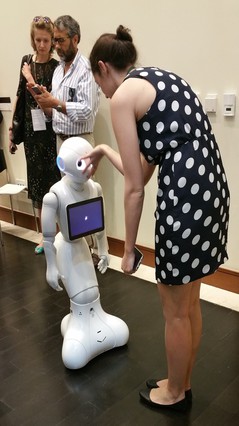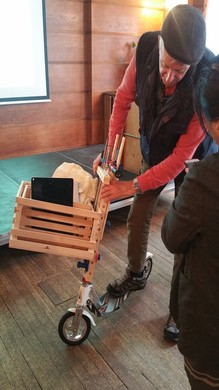Opening the source
 Recently, Michael Salmony, who has appeared here before appeared horrified to discover open access, the movement for publishing scientific research so it's freely accessible to the public (who usually paid for it) instead of closed to subscribers. In an email, he wrote, "...looks like the Internet is now going to destroy science as well".
Recently, Michael Salmony, who has appeared here before appeared horrified to discover open access, the movement for publishing scientific research so it's freely accessible to the public (who usually paid for it) instead of closed to subscribers. In an email, he wrote, "...looks like the Internet is now going to destroy science as well".
This is not my view.
The idea about science that I grew up with was that scientists building on and reviewing each other's work is necessary for good science, a self-correcting process that depends on being able to critique and replicate each other's work. So the question we should ask is: does the business model of traditional publishing support that process? Are there other models that would support that process better? Science spawns businesses, serves businesses, and may even be a business itself, but good-quality science first serves the public interest.
There are three separate issues here. The first is the process of science itself: how best to fund, support, and nurture it. The second is the business model of scientific *publishing*. The third, which relates to both of those, is how to combat abuse. Obviously, they're interlinked.
The second of these is the one that resonates with copyright battles past. Salmony: "OA reminds me warmly of Napster disrupting music publishing, but in the end iTunes (another commercial, quality controlled) model has won."
iTunes and the music industry are not the right models. No one dies of lack of access to Lady Gaga's latest hit. People *have* died through being unable to afford access to published research.
Plus, the push is coming from an entirely different direction. Napster specifically and file-sharing generally were created by young, anti-establishment independents who coded copyright bypasses because they could. The open access movement began with a statement of principles codified by university research types - mavericks, sure, but representing the Public Library of Science, Open Society Institute, BioMed Central, and universities in Montreal, London, and Southampton. My first contact with the concept was circa 1993, when World Health Organization staffer Christopher Zielinski raised the deep injustice of pricing research access out of developing countries' reach.
Sci-Hub is a symptom, not a cause. Another symptom: several months ago, 60 German universities canceled their subscriptions to Elsevier journals to protest the high fees and restricted access. Many scientists are offended at the journals' expectation that they will write papers for free and donate their time for peer review while then charging them to read the published results. One way we know this is that Sci-Hub builds its giant cache via educational institution proxies that bypass the paywalls. At least some of these are donated by frustrated people inside those institutions. Many scientists use it.
As I understand it, publication costs are incorporated into research grants; there seems no reason why open access should impede peer review or indexing. Why shouldn't this become financially sustainable and assure assure quality control as before?
A more difficult issue is that one reason traditional journals still matter is that academic culture has internalized their importance in determining promotions and tenure. Building credibility takes time, and many universities have been slow to adapt. However, governments and research councils in Germany, the UK, and South Africa are all pushing open access policies via their grant-making conditions.
Plus, the old model is no longer logistically viable in many fields as the pace of change accelerates. Computer scientists were first to ignore it, relying instead on conference proceedings and trading papers and research online.
Back to Salmony: "Just replacing one bad model with another one that only allows authors who can afford to pay thousands of dollars (or is based on theft, like Sci Hub) and that threatens the quality (edited, peer review, indexed etc) sounds less than convincing." In this he's at odds with scientists such as Ben Goldacre, who in 2007 called open access "self-evidently right and good".
This is the first issue. In 1992, Marcel C. LaFollette's Stealing into Print: Fraud, Plagiarism, and Misconduct in Scientific Publishing documented many failures of traditional peer review. In 2010, the Greek researcher John Ioannidis established how often medical research is retracted. At Retraction Watch, science journalist Ivan Oransky finds remarkable endemic sloppiness and outright fraud. Admire the self-correction, but the reality is that journals have little interest in replication, preferring newsworthy new material - though not *too* new.
Ralph Merkle, the "third man", alongside Whit Diffie and Martin Hellman, inventing public key cryptography, has complained that journals favor safe, incremental steps. Merkle's cryptography idea was dismissed with: "There is nothing like this in the established literature." True. But it was crucial for enabling ecommerce.
Salmony's third point: "[Garbage] is the plague of the open Internet", adding a link to a Defon 26 talk. Sarah Jeong's Internet of Garbage applies.
Abuse and fakery are indeed rampant, but a lot is due to academic incentives. For several years, my 2014 article for IEEE Security & Privacy explaining the Data Retention and Investigatory Powers Act (2014) attracted invitations to speak at (probably) fake conferences and publish papers in (probably) fake journals. Real researchers tell me this is par for the course. But this is a problem of human predators, not "the open Internet", and certainly not open access.
Illustrations: Participants in drafting the Budapest principles (via Wikimedia).
Wendy M. Grossman is the 2013 winner of the Enigma Award. Her Web site has an extensive archive of her books, articles, and music, and an archive of earlier columns in this series. Stories about the border wars between cyberspace and real life are posted occasionally during the week at the net.wars Pinboard - or follow on Twitter.



 In movies and TV shows, robot assistants are humanoids, but that future is too far away to help the onrushing 4.8 million. Today's care-oriented robots have biological, but not human, inspirations: the
In movies and TV shows, robot assistants are humanoids, but that future is too far away to help the onrushing 4.8 million. Today's care-oriented robots have biological, but not human, inspirations: the 